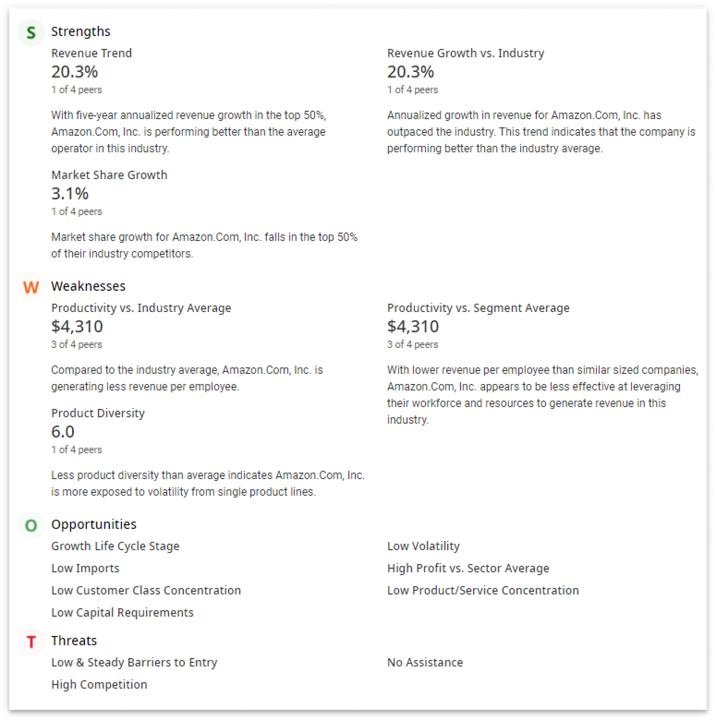What is a SWOT analysis?
SWOT stands for strengths, weaknesses, opportunities and threats.
Businesses at various stages use the SWOT framework to help understand an organization’s position in its industry. Using the SWOT framework can help you reassess the state of your business, and evaluate where you want to take it moving forward.
Performing a SWOT analysis helps you see your business through a fresh pair of eyes. Business professionals can get bogged down by the minutiae working day to day in the same organization, often losing touch with the bigger picture. Reducing the state of your company into strengths, weaknesses, opportunities and threats can offer up new perspectives and new possibilities that can later inform business strategies.

How to do a SWOT analysis
While a good SWOT analysis typically starts with the management team, anyone from CEOs to interns can provide input. In fact, the more collaboration the better. Remember that a SWOT analysis is intended to reveal fresh perspectives, so bringing in strategy-minded employees across management teams and beyond can help bring new information to light.
Usually, a SWOT analysis is portrayed as a square sectioned into four smaller squares. Each of the smaller squares take features a different a component of SWOT. This image from Wikipedia is a great example of a SWOT analysis template.
As this SWOT analysis template shows, strengths and weaknesses usually represent internal factors related to the organization, whereas opportunities and threats usually represent external factors.
Internal factors are aspects like the company’s balance sheet, its human capital and the state of its operational capabilities. External factors are the forces beyond the organizations control such as the state of the global supply chain, the exchange rate with a trade partner and consumer demand.
Breaking down SWOT analysis meaning
- Strengths are what the organization does well. The things that make the organization stand out from the rest of the industry. Since this relates to internal factors of a company, a strength can be its employees, its financial health or its technological capabilities. Ask yourself: What does our company do better than the competition? What is the main source of our success?
- Weaknesses are the limitations in the way of greater success. The internal factors the organization needs to improve on. These can be anything from the less-than-ideal financial health of the company to the low morale among its employees. Ask yourself: What can we do to improve how we run our company? What is stopping us from being more successful?
- Opportunities are the external factors a company can leverage for success. An example might be a favorable exchange rate for a company that primarily exports. Ask yourself: Is there an untapped market we can target? Are we fully optimizing the demand for our good or service?
- Threats are the external factors that put the organization’s success at risk. For example, the change in consumer spending caused by increased taxes might reduce sales. Another example: a company that’s dependent on a raw material produced across the globe is bound by the flow of global trade. Ask yourself: Are we prepared for the worst-case scenario? How are we faring in relation to our main competitors?
Example: Amazon SWOT analysis chart
This example SWOT analysis chart evaluates Amazon.com Inc. (Amazon) and provides a real-world illustration and application of this framework. Not only is the SWOT analysis template completed with examples of actual internal and external factors, it demonstrates that SWOT analysis is helpful for organizations of any size.
For instance, an example SWOT analysis strength for Amazon includes rising market share, meaning the company may be able to leverage its growing size.

Source: IBISWorld’s Company Benchmarking solution. Learn more
While it may seem daunting to apply the SWOT framework to large companies like Amazon, using pre-populated templates like the one above can provide a solid starting point and offer some consistency in your approach.
Last thoughts
The purpose of a SWOT analysis is to start from the basics in order to view the organization with a new approach. This seemingly oversimplification of the organization helps decision makers overcome preconceived notions. SWOT analysis is meant to build a bridge from a casual discussion about business improvements to smart and informed strategic planning.
To fortify that bridge, you can use other frameworks, like the PESTLE analysis or Porter’s Five Forces model.
Once you have considered opportunities and threats, you can build further by conducting a competitive analysis to identify your top competitors or calculating a company’s industry market share to reevaluate competitiveness. If you want to move forward after laying out your strengths and weaknesses, find out about how the 13 key financial ratios can be used to benchmark company performance.
Source from Ibisworld
Disclaimer: The information set forth above is provided by Ibisworld independently of Alibaba.com. Alibaba.com makes no representation and warranties as to the quality and reliability of the seller and products.




